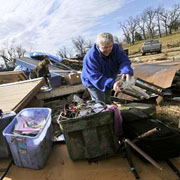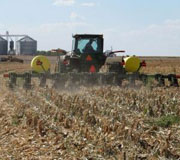-
(单词翻译:双击或拖选)
US Sets Extreme Weather Records in 2011
Extreme weather cut a path of destruction across the United States in 2011.
For Bill Wing, it began 12 months ago, on New Year’s Day, as he surveyed the damage from a tornado1 that touched down in Cincinnati, Arkansas.
“It sounded like a freight train coming," he says. "We weren't in the direct path of it. You could feel the wind moving and the shaking, more like an earthquake for us.”
That tornado was among 1,600 that crisscrossed the nation in 2011. Twelve weather-related disasters accounted for $1 billion or more each in economic losses, a new record, according to Chris Vaccaro, spokesman for the National Weather Service.
“We’ve seen historic events of nearly every weather category," says Vaccaro. "So in terms of snow storms, and hurricanes and floods and droughts, all of these events this year ranked in the top three or even the highest ever recorded.”
 |
| Margie Sisemore cleans after a tornado destroyed several homes in the small town of Cincinnati, Arkansas. That tornado was among 1,600 that crisscrossed the US in 2011. |
The extreme weather affected2 millions of people, claimed 1,000 lives, resulted in 8,000 injuries and totaled more than $52 billion in economic losses. The most costly3, according to David Brown, of the National Oceanic and Atmospheric4 Administration, was the year-long drought that continues to grip southern plains states.
“We’re looking at $6 to $8 billion in damage from agricultural losses, from fire losses, in places like Texas, New Mexico and Oklahoma and if the drought persists for the next several months, as we expect it will, those damages will only increase.”
Vaccaro says a growing population and expanding infrastructure5 account in part for the damages, but also large-scale cyclical weather patterns came into play in 2011. “First and foremost was La Nina in the eastern Pacific which altered our standard storm patterns. And we also had a pattern in the Arctic called the Arctic Oscillation.
That was a big factor in the winter and spring months, allowing cold air to flow into the United States that helped spawn6 snow storms and also support the tornado season.”
 |
| In 2011, Texas farmers contended with a year-long drought which continues to grip southern plains states. |
While there is no evidence to connect global warming with specific local weather events, Vaccarro says this past year’s weather extremes are consistent with what climate experts are projecting for the long-term. Warming temperatures provide more energy and water in the atmosphere and consequently trigger more intense droughts, heavier rainfall and stronger storms.
Peter Altman, climate and clean air campaign director for the Natural Resources Defense7 Council, expects the situation to get worse as global temperatures continue to rise. He advocates action to reduce climate changing emissions8 and mitigate9 their impact.
“We’ve got to better prepare ourselves to manage these kind of weather events, whether they are droughts, wildfires, heat waves, floods, and that means in terms of emergency management in providing the kind of health assistance that you need in the aftermath of those kinds of events.”
The 2011 weather extremes could be the “new normal,” says Vaccaro with the National Weather Service. The agency is taking steps to build a weather-ready nation, which calls on a growing network of partners in the public and private sector10 to work together to prepare for future disasters.
 收听单词发音
收听单词发音
1
tornado

|
|
| n.飓风,龙卷风 | |
参考例句: |
|
|
|
2
affected

|
|
| adj.不自然的,假装的 | |
参考例句: |
|
|
|
3
costly

|
|
| adj.昂贵的,价值高的,豪华的 | |
参考例句: |
|
|
|
4
atmospheric

|
|
| adj.大气的,空气的;大气层的;大气所引起的 | |
参考例句: |
|
|
|
5
infrastructure

|
|
| n.下部构造,下部组织,基础结构,基础设施 | |
参考例句: |
|
|
|
6
spawn

|
|
| n.卵,产物,后代,结果;vt.产卵,种菌丝于,产生,造成;vi.产卵,大量生产 | |
参考例句: |
|
|
|
7
defense

|
|
| n.防御,保卫;[pl.]防务工事;辩护,答辩 | |
参考例句: |
|
|
|
8
emissions

|
|
| 排放物( emission的名词复数 ); 散发物(尤指气体) | |
参考例句: |
|
|
|
9
mitigate

|
|
| vt.(使)减轻,(使)缓和 | |
参考例句: |
|
|
|
10
sector

|
|
| n.部门,部分;防御地段,防区;扇形 | |
参考例句: |
|
|
|















